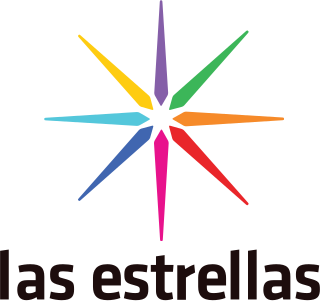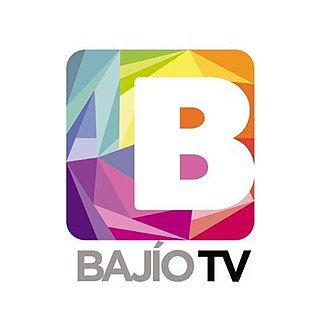XHAS-TDT is a television station in Tijuana, Baja California, Mexico, carrying Canal 66. It is owned by a Mexican company whose largest single investor is Entravision Communications, a U.S.-based broadcaster with radio and television stations in San Diego, including Univision affiliate KBNT-CD, and a similar interest in Milenio Televisión affiliate XHDTV-TDT. XHAS-TDT's transmitter is on Mount San Antonio in Tijuana.
XHTV-TDT is a Mexican television station, serving Mexico City as the flagship relay of the N+ Foro channel. The station is owned-and-operated by locally based Grupo Televisa alongside XEW-TDT, XHGC-TDT and XEQ-TDT carrying Las Estrellas, El 5* and NU9VE respectively, all four channels are run by TelevisaUnivision, which Grupo Televisa owns a majority stake in the company, Foro itself is operated by Triton Comunicaciones, which was Televisa's news division prior to the 2022 split.

XHCH-TDT is a television station in Chihuahua, Chihuahua. Broadcasting on virtual channel 1, XHCH is owned by TV Azteca and broadcasts its Azteca Uno network.

XHIT-TDT is a TV Azteca television station in Chihuahua, Chihuahua, Mexico. XHIT carries TV Azteca's Azteca Uno with a one-hour delay.
XHTRES-TDT was a full-power television station in Mexico City, Mexico, broadcasting in digital on UHF channel 27. From 2006 to 2015, it was the flagship station of the now defunct network cadenatres and from 2013 to 2020, it was the flagship station of the Excélsior TV news network. It was licensed to Compañía Internacional de Radio y Televisión, S.A. (CIRT), which is owned by Grupo Empresarial Ángeles (GEA), a company headed by Olegario Vázquez Raña and directed by Olegario Vázquez Aldir, through its Grupo Imagen communications unit.
XEDK-TDT is a television station in Guadalajara, Jalisco, broadcasting on virtual channel 13. Historically, XEDK was considered one of the most important local television stations in western Mexico; It forms part of the Telsusa Canal 13 network owned by Albavisión.

Azteca Uno, is a Mexican national broadcast television network owned by TV Azteca, with more than 100 transmitters across the country. Azteca Uno broadcasts on virtual channel 1. Azteca Uno programming is available in Mexico on satellite via Sky and Dish Network, as well as all Mexican cable systems, and some Azteca Uno programming were seen in the United States on Azteca América.
XHTX-TDT is a television station in Tuxtla Gutiérrez, Chiapas. The station is owned by Telemisión, S.A. de C.V., a business of the Partida Amador family.

Las Estrellas is a Mexican television network owned by TelevisaUnivision. Its first official broadcast took place on 21 March 1951. It airs free-to-air through affiliate stations throughout Mexico, based on XEW-TDT in Mexico City.
Television in Latin America currently includes more than 1,500 television stations and more than 60 million TV sets throughout the 20 countries that constitute Latin America. Due to economic and political problems television networks in some countries of this region have developed less than the North American and European networks, for instance. In other countries like Colombia or Chile, television broadcasting has historically been public-broadcast dominated until the 1990s. The largest commercial television groups are Mexico-based Televisa, Brazil-based Globo and Canada-based Canwest Latin American Group. Due to the shared language of Spanish by two thirds of Latin Americans a lot of programmes and broadcasters operate throughout the region, offering both United States television and Spanish-language television.

XHST-TDT, known as Tele Yucatán, is a television station on virtual channel 4 in Mérida, Yucatán. It is owned by Sistema Tele Yucatán, S.A. de C.V., a company wholly owned by the government of the State of Yucatán, with a schedule of primarily local programs including news, sports, culture and entertainment.

Televisión Independiente de México was a Mexican national television network founded in 1965 by Eugenio Garza Sada. It operated until 1973, when it merged with its primary competitor, Telesistema Mexicano, owned by Emilio Azcárraga Vidaurreta, to form the Televisa conglomerate. Televisa absorbed all of TIM's assets, including its television transmitters and its series, including pioneering programs such as El Chavo del Ocho.

The Instituto Mexicano de la Televisión, known commercially as Imevisión after 1985, was a state broadcaster and federal government agency of Mexico. At its height, Imevisión programmed two national networks and additional local stations in Mexico City, Chihuahua, Ciudad Juárez, Guadalajara, Mexicali, Tijuana and Monterrey.

Grupo Radio Centro is a Mexico City-based owner and operator of radio stations. It owns 30 radio stations in Mexico and the United States, including 8 radio stations in Mexico City.
XHJMA-TV was a television station in Hidalgo del Parral, Chihuahua, Mexico, broadcasting on channel 3 from 1969 until April 2014.

XHL-TDT is a television station in León, Guanajuato, Mexico on virtual channel 12. The station is part of the Televisa Regional division of Televisa and is known as Televisa del Bajío, airing local content and programming for viewers in León and Guanajuato.
XHA-TDT is a television station in Durango, Durango, Mexico. XHA broadcasts on virtual channel 10 and is currently an independent station.
XHTVL-TDT is a television station in Villahermosa, Tabasco, Mexico, the flagship station of the Canal 13 regional network owned by Albavisión. It also airs programming from elnueve, ATV and La Red.

Imagen Televisión is a national broadcast television network in Mexico, owned by Grupo Imagen. It launched on October 17, 2016, at 8 p.m.
Canal 13 is a regional broadcasting network operating in parts of Mexico, a division of Albavisión. Its largest subsidiary, Telsusa Televisión México, S.A. de C.V., holds the concessions for 12 TV stations, primarily in southeastern Mexico, obtained in the IFT-6 television station auction of 2017. The Canal 13 network also includes full-fledged TV stations in Villahermosa, San Cristóbal de las Casas—Tuxtla Gutiérrez and Tapachula, as well as their repeaters, and an additional station in Michoacán. All Canal 13 stations are assigned virtual channel 13.








